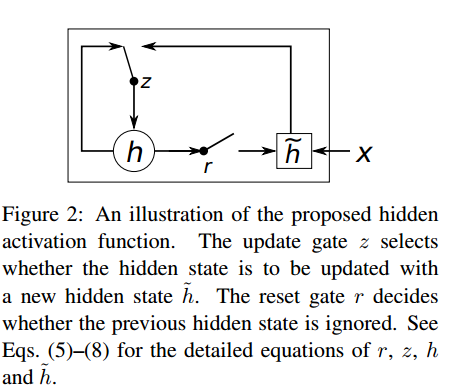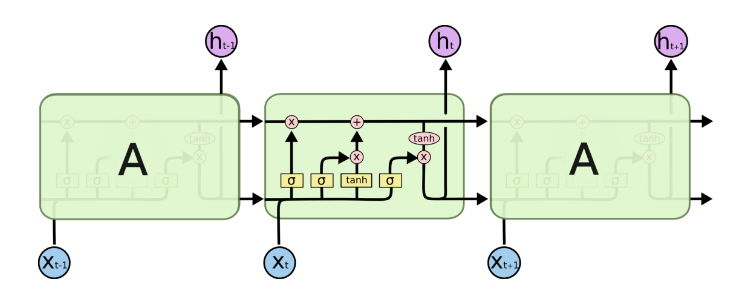参考:链接。
RNNCell
- BasicRNNCell
- GRUCell
- BasicLSTMCell
- LSTMCell
- MultiRNNCell
抽象类RNNCell
所有的rnncell均继承于RNNCell, RNNCell主要定义了几个抽象方法:
1 def __call__(self, inputs, state, scope=None): 2 raise NotImplementedError("Abstract method") 3 4 @property 5 def state_size(self): 6 raise NotImplementedError("Abstract method") 7 8 @property 9 def output_size(self): 10 raise NotImplementedError("Abstract method")
上述方法,__call__在对象被使用时调用,其他可以看做属性方法,主要用作获取状态state的大小,cell的输出大小。既然对象使用时会调用__call__,那么各类RNN的操作都定义在这个方法中。接下来,我们就针对各个不同的cell来详细介绍各类RNN。
BasicRNNCell
这个cell是最基础的一个RNNCell,可以看做是对一般全连接层的拓展,除了在水平方向加入时序关系,可以用下图表示:

而BasicRNNCell的初始化方法可如代码所示:
1 def __init__(self, num_units, input_size=None, activation=tanh): 2 if input_size is not None: 3 logging.warn("%s: The input_size parameter is deprecated.", self) 4 self._num_units = num_units 5 self._activation = activation
初始化只需要给出num_units,用来指有多少个隐藏层单元;而activation指使用哪种激活函数用作激活输出。而对应的RNN操作定义在__call__方法中:
1 def __call__(self, inputs, state, scope=None): 2 """Most basic RNN: output = new_state = activation(W * input + U * state + B).""" 3 with vs.variable_scope(scope or type(self).__name__): # "BasicRNNCell" 4 output = self._activation(_linear([inputs, state], self._num_units, True)) 5 return output, output
很清晰,inputs表示隐藏层的输入,state表示上个时间的隐藏层状态,也可以说是上一次隐藏层向自身的输出,对于第一次输入,则需要初始化state,对应初始化方法有很多种,可以使用tensorflow提供的各种初始化函数。在__call__中,对输入inputs和state进行activation(wx+b),用作下次的输入。
GRUCell
GRU是对RNN的一种改进,相比LSTM来说,也可以看做是对LSTM的一种简化,是Bengio在14年提出来的,用作机器翻译。先看一下GRU的基本结构:

这里我们结合代码来看原理:
def __call__(self, inputs, state, scope=None): """Gated recurrent unit (GRU) with nunits cells.""" with vs.variable_scope(scope or type(self).__name__): # "GRUCell" with vs.variable_scope("Gates"): # Reset gate and update gate. # We start with bias of 1.0 to not reset and not update. r, u = array_ops.split(1, 2, _linear([inputs, state], 2 * self._num_units, True, 1.0)) r, u = sigmoid(r), sigmoid(u) with vs.variable_scope("Candidate"): c = self._activation(_linear([inputs, r * state], self._num_units, True)) new_h = u * state + (1 - u) * c return new_h, new_h
GRUCell的初始化与RNN一样,给出输入和初始化的state,在使用对象时,利用输入和前一个时间的隐藏层状态,得到对应的Gates: r, u, 然后利用r更新cell状态,最后利用u得到新的隐藏层状态。对于RNN的改进,最厉害的莫过于下面的,而且有很多变种,这里tensorflow中只有几个简单常见的cell。接下来,我们开始看看LSTM。
BasicLSTMCell
这个cell可以看做是最简单的LSTM,在每个连接中没有额外的连接,即其他变种在连接中加入各种改进。对于BasicLSTMCell,可以如下图所示:

同样的,我们结合代码来看它的原理:
1 def __call__(self, inputs, state, scope=None): 2 """Long short-term memory cell (LSTM).""" 3 with vs.variable_scope(scope or type(self).__name__): # "BasicLSTMCell" 4 # Parameters of gates are concatenated into one multiply for efficiency. 5 if self._state_is_tuple: 6 c, h = state 7 else: 8 c, h = array_ops.split(1, 2, state) 9 concat = _linear([inputs, h], 4 * self._num_units, True) 10 11 # i = input_gate, j = new_input, f = forget_gate, o = output_gate 12 i, j, f, o = array_ops.split(1, 4, concat) 13 14 new_c = (c * sigmoid(f + self._forget_bias) + sigmoid(i) * 15 self._activation(j)) 16 new_h = self._activation(new_c) * sigmoid(o) 17 18 if self._state_is_tuple: 19 new_state = LSTMStateTuple(new_c, new_h) 20 else: 21 new_state = array_ops.concat(1, [new_c, new_h]) 22 return new_h, new_state
lstm有三个门,inputs, forget, output, 而中间cell用来管理结合他们生产需要的输出。在初始化结束之后,利用输入分别得到对应的门的输出,然后利用这三个门的信息分别更新cell和当前隐藏层状态。f 用来控制遗忘之前的信息和记忆当前信息的比例,进而更新cell,lstm可以看做是一种复杂的激活函数,它的存在依赖RNN的递归性。BasicLSTMCell只是个最基本的LSTM,而完整的LSTM可能比这个复杂,可以参看blog。
MultiRNNCell
对于MultiRNNCell,只能贴出完整代码来分析了:
1 class MultiRNNCell(RNNCell): 2 """RNN cell composed sequentially of multiple simple cells.""" 3 4 def __init__(self, cells, state_is_tuple=False): 5 """Create a RNN cell composed sequentially of a number of RNNCells. 6 7 Args: 8 cells: list of RNNCells that will be composed in this order. 9 state_is_tuple: If True, accepted and returned states are n-tuples, where 10 `n = len(cells)`. By default (False), the states are all 11 concatenated along the column axis. 12 13 Raises: 14 ValueError: if cells is empty (not allowed), or at least one of the cells 15 returns a state tuple but the flag `state_is_tuple` is `False`. 16 """ 17 if not cells: 18 raise ValueError("Must specify at least one cell for MultiRNNCell.") 19 self._cells = cells 20 self._state_is_tuple = state_is_tuple 21 if not state_is_tuple: 22 if any(nest.is_sequence(c.state_size) for c in self._cells): 23 raise ValueError("Some cells return tuples of states, but the flag " 24 "state_is_tuple is not set. State sizes are: %s" 25 % str([c.state_size for c in self._cells])) 26 27 @property 28 def state_size(self): 29 if self._state_is_tuple: 30 return tuple(cell.state_size for cell in self._cells) 31 else: 32 return sum([cell.state_size for cell in self._cells]) 33 34 @property 35 def output_size(self): 36 return self._cells[-1].output_size 37 38 def __call__(self, inputs, state, scope=None): 39 """Run this multi-layer cell on inputs, starting from state.""" 40 with vs.variable_scope(scope or type(self).__name__): # "MultiRNNCell" 41 cur_state_pos = 0 42 cur_inp = inputs 43 new_states = [] 44 for i, cell in enumerate(self._cells): 45 with vs.variable_scope("Cell%d" % i): 46 if self._state_is_tuple: 47 if not nest.is_sequence(state): 48 raise ValueError( 49 "Expected state to be a tuple of length %d, but received: %s" 50 % (len(self.state_size), state)) 51 cur_state = state[i] 52 else: 53 cur_state = array_ops.slice( 54 state, [0, cur_state_pos], [-1, cell.state_size]) 55 cur_state_pos += cell.state_size 56 cur_inp, new_state = cell(cur_inp, cur_state) 57 new_states.append(new_state) 58 new_states = (tuple(new_states) if self._state_is_tuple 59 else array_ops.concat(1, new_states)) 60 return cur_inp, new_states
创建对象时,可以看到初始化函数中不再是输入,而是变成了cells,,即一个cell是一层,多个cell便有多层RNNcell。而在使用对象时,单层可以看做多层的特例,对于输入inputs和state,同时得到多个cell的当前隐藏层状态,用作下个时间步。看似麻烦,其实很简洁,就是加入了对多个cell的计算,最后得到的新的隐藏层状态即每个cell的上个时间步的输出。